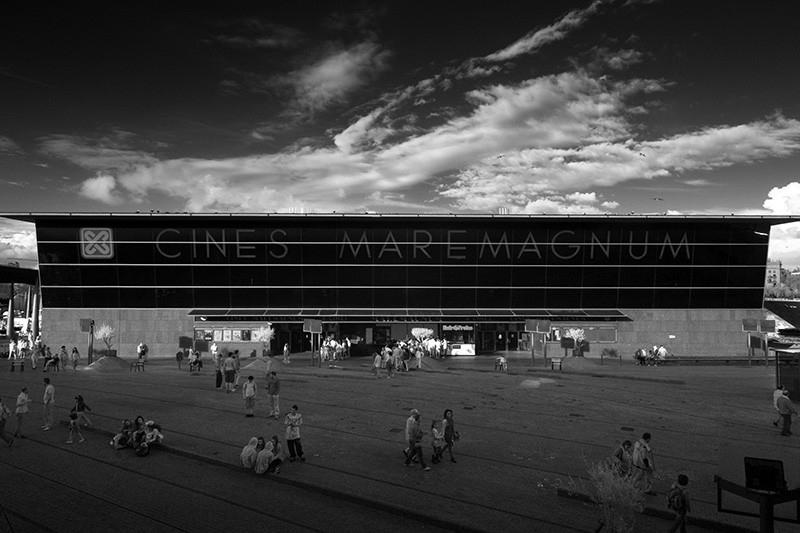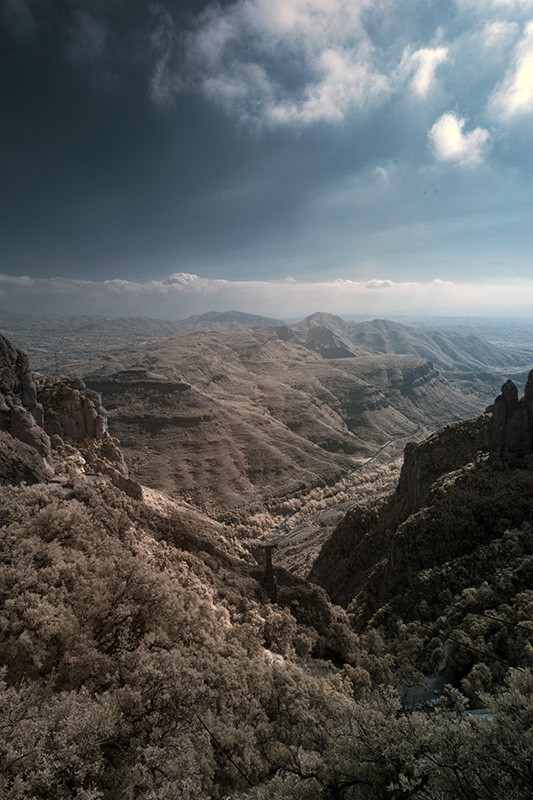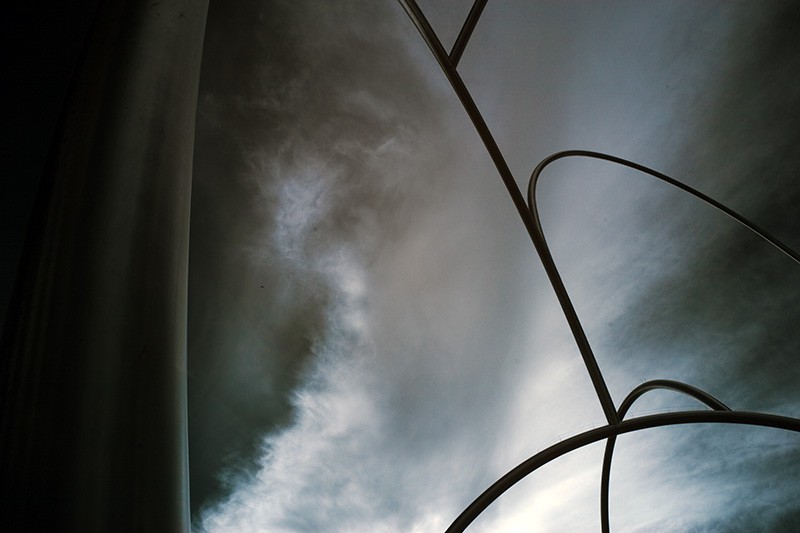 I've filled up the last few posts with some infrared photographs, of people and places, wavelengths redder than red. The process that created these images is long and complicated and now I shall try to explain how I did it. But not why. I can't explain why.
I've filled up the last few posts with some infrared photographs, of people and places, wavelengths redder than red. The process that created these images is long and complicated and now I shall try to explain how I did it. But not why. I can't explain why.When Ansel Adams decided to set down his sorcerer's ways in book form, he came up with THE CAMERA, THE NEGATIVE, and THE PRINT, three weighty books that are still fetishised by sad disciples of the ancient religion of film photography. I grew up in Britain in the 1980s and so my natural instinct is to destroy the past; smash the four olds, but nonetheless Adams' compartmentalisation of the photographic process seems sensible, despite the fact that he was the product of the great Satan. First there is the camera; then there is the exposure; and then there is the electronic wizardry that turns a muddy-looking red smear into a visual symphony of angles and contrasts. I will not bother with THE PRINT because that kind of thing is old-hat, pre-internet. We have moved beyond physical media. This post is about THE CAMERA, the input device. The combination of camera and lens. The next post will be about THE NEGATIVE, the digital file.
Painters have their brushes, photographers also have their machines. Some people fetishise the technology and never move beyond. These are the people who buy coffee table books filled with photographs of guitars, the kind of people who write lengthy blog posts about the smallest technical details of old cameras. Boring empty people, the kind who write at length about (for example) infrared photography. They are wasting their lives, and yours. Here's a bloody rainbow:
 The CAMERA
The CAMERALet's suppose that you want to take hand-held infrared exposures. You don't want to put the camera on a tripod and wait for five seconds per exposure, you want to hold the camera in your hand and shoot whatever the bloody hell crosses your path. You're impatient, easily bored, you grew up in Britain in the 1980s and you hate the past and slow things. You worship speed and are naturally suspicious of depth. You hate waiting. Smash and hate.
In earlier posts I stuck a visible light blocking filter onto a conventional colour digital camera, with surprisingly good results, but that only worked because the camera I used was unusually sensitive to infrared, being old. A rare example of an old thing still being useful today, along with e.g. the Browning Hi-Power pistol and the Boeing B-52 bomber. Modern cameras tend to be much less sensitive to IR; my 5D Mk II has such a strong infrared blocking filter that I have to take thirty-second exposures at ISO 1600 in bright sunlight to get a signal. A tedious process. If God - who does not exist - had intended me to stand still for thirty seconds he would have broken my legs.
Or he would have made me without legs. And even then I would still move around. Like that athlete, you know. Aimee Mullins, who was in Cremaster III. She was born without fibula bones and so they took her legs off when she was young; then she became a sprinter, a job that involves moving around a lot whenever a gun goes off. Imagine if they dropped her into the Afghanistan war, with all those guns going off; she'd never stop running. Which would be perfectly sensible given that it's the Afghanistan war. She'd probably survive better than people who just stood still. I must take less cocaine. Fewer cocaine. I must take less of it.
 There exist a very few dedicated infrared cameras, such as the Fuji IS Pro, but these tend to be very expensive and aimed at nerds and sad technical boffins. The next option, and one of the most popular, is to take a cheap old camera and send it off to the appropriate company to be converted into an infrared camera. The conversion process involves taking off the infrared blocking filter and replacing it with a visible light blocking filter. The camera still functions as it did before, but instead of recording visible light it records infrared.
There exist a very few dedicated infrared cameras, such as the Fuji IS Pro, but these tend to be very expensive and aimed at nerds and sad technical boffins. The next option, and one of the most popular, is to take a cheap old camera and send it off to the appropriate company to be converted into an infrared camera. The conversion process involves taking off the infrared blocking filter and replacing it with a visible light blocking filter. The camera still functions as it did before, but instead of recording visible light it records infrared.But which camera? If money is no object there's nothing to stop you from buying a Nikon D700 or Canon 7D etc and converting that, but as I have always said, if money is no object, why the hell are you bothering with cameras? Live your life of ease, don't waste time photographing it.
 The absolute cheapest digital SLR on the used market in Britain as I write these words is the Canon D30, which is a three megapixel model from yonks ago. Three megapixels does not excite me; but for a tiny bit more money you cold have a Canon D60, which is a six megapixel model that people tend to confuse with the more recent 60D. However the D60 only goes up to ISO 1000, which is limiting. One step up again, £130 or so, gets you a used 10D, which seems to be a technological sweet spot, and a popular choice for this sort of thing. It's not really good enough that you'd miss throwing away its ability to take pictures with visible light, and it's not so old and noisy and slow that it's a waste of money. Here's mine, with the battery grip and a Samyang 14mm f/2.8:
The absolute cheapest digital SLR on the used market in Britain as I write these words is the Canon D30, which is a three megapixel model from yonks ago. Three megapixels does not excite me; but for a tiny bit more money you cold have a Canon D60, which is a six megapixel model that people tend to confuse with the more recent 60D. However the D60 only goes up to ISO 1000, which is limiting. One step up again, £130 or so, gets you a used 10D, which seems to be a technological sweet spot, and a popular choice for this sort of thing. It's not really good enough that you'd miss throwing away its ability to take pictures with visible light, and it's not so old and noisy and slow that it's a waste of money. Here's mine, with the battery grip and a Samyang 14mm f/2.8: I have taped over the 10D logo with gaffer tape
I have taped over the 10D logo with gaffer tape  The lens is an old Olympus 21mm f/3.5. It's made of metal, painted black, and so is the camera, but it must be a different kind of paint. Altogether. "I'm the locksmith. And... I'm the locksmith."
The lens is an old Olympus 21mm f/3.5. It's made of metal, painted black, and so is the camera, but it must be a different kind of paint. Altogether. "I'm the locksmith. And... I'm the locksmith."While I'm photographing cameras, here's my Olympus OM-10:
 The colour makes it look like a rare special edition, like one of those gold Leicas, of which there have been many down the years. There was never a gold Olympus 24mm f/2.8, although there was a gold OM-2N. Because I'm on a roll, here's some fruit:
The colour makes it look like a rare special edition, like one of those gold Leicas, of which there have been many down the years. There was never a gold Olympus 24mm f/2.8, although there was a gold OM-2N. Because I'm on a roll, here's some fruit: I also photographed a cup of tea, but I'm not going to post the image because it looked like a mug of warm semen. It really did. I'm not just saying that to be shocking; it really did look like a mug of warm semen. I drank it just the same.
I also photographed a cup of tea, but I'm not going to post the image because it looked like a mug of warm semen. It really did. I'm not just saying that to be shocking; it really did look like a mug of warm semen. I drank it just the same.The Canon 10D
The 10D was a kind of slicked-up refinement of the D60, with a tougher all-metal body and ISO 3200. It uses cheap and widely-available BP-511 batteries and takes ordinary Compact Flash cards, although it has trouble with cards larger than 2gb. The most recent firmware will read larger cards, but I have had trouble with the camera locking up when a 4gb card is almost filled up, so I use a couple of good fast 2gb cards instead. 2gb equals roughly 240 RAW shots, and you will be shooting RAW. Dunno why I write RAW in capitals, it's not an acronym. It's not even a file extension (the 10D produces .CRW files, which it batches into hundred-file folders, which are a bugger to archive).
NB Companies other than Canon have made digital SLRs, and some continue to do so. But Canon made a lot of them, and thus they tend to be slightly cheaper on the used market. The direct parallel universe Nikon-world analogue of the 10D would be the Nikon D100, which from what I have read is just as good and bad as the 10D (good image quality, slow). Nikon also made a string of six-megapixel SLRs with slightly cheaper bodies - the D70 and D50 and D40 in that order - which are apparently just as handy. Fuji's S2 is also available cheaply, but according to Lifepixel - more about them later - they cannot be converted into infrared cameras. I owned one for a short while; it was sensitive enough to infrared that it would record a signal with two, three-second exposures, but not shorter than that.
The battery grip is fairly cheap, and you can use it with the D30 and D60, if you have one. A rare example of Canon maintaining backwards compatibility with its accessories. On a physical level my example is well-used but still feels like a single block of metal. The one major physical limitation is that it can't mount EF-S lenses. It predated the EF-S standard by a few months and the lens mount simply won't accept them. This is one of the reasons why the 10D is so cheap; you're restricted to Canon's full-frame lens range or digital-only lenses by Sigma and Tamron and so forth. The 20D didn't have this problem and this is one of the reasons why it's about £200 on the used market, a substantial step up from the 10D.
There is another thing. The 10D is very slow. Slow to start up, slow to write images to the card, slow to play them back. If you're taking intermittent landscape shots you'll never overwhelm the buffer. If however you're taking fashion-style portraits you'll quickly find yourself mentally swearing as the camera says BUSY at you. It takes ages to clear the images to the card - less than a minute, according to DPReview, but it feels like forever - and until it does you can't review the most recent shot. If God had intended for me to stand there for a minute watching a bar slowly count down to zero he would have made me a deep sea diver. In this respect the older Kodak DCS 560 was much better; it had a smaller buffer, but it cleared it promptly.
 What is it with chins? Why did I take so many photographs of chins? What was wrong with me? Perhaps I was subconsciously thinking of the figurehead on the prow of a ship. I'm not sure why the Royal Navy thought that putting naked women on the front of their ships would strike terror into the enemy. Especially given that the enemy were usually French or Spanish, who love naked women and are familiar with them.
What is it with chins? Why did I take so many photographs of chins? What was wrong with me? Perhaps I was subconsciously thinking of the figurehead on the prow of a ship. I'm not sure why the Royal Navy thought that putting naked women on the front of their ships would strike terror into the enemy. Especially given that the enemy were usually French or Spanish, who love naked women and are familiar with them.The last image is of Ulorin Vex at the Heygate estate in London, with the Strata in the background. There was a man cleaning the windows right at the very top of the building, and I hope he gets paid a lot of money. Cleaning the windows of a skyscraper would be a fantastic job if you were a photographer, because you'd be able to shoot panoramas of London all day long. And if you had a rifle and plenty of ammunition you could basically own London, at least until someone comes along with a helicopter. Or a gust of wind tips you out of your hoist.
Still, in its day the 10D was only one step down from the range-topping 1D and 1Ds and no doubt plenty of people were thrilled to get their hands on one. It seems beastly to rag on such a faithful servant. Nonetheless I curse its slow buffer and slow image review and wish its output was cleaner at ISO 800. Infrared photography generally requires a tonne of post-processing, pushing and pulling and contrast enhancement, and that tends to magnify the noise and grain.
A few months after the 10D came out, Canon released the cheaper 300D, which was the first budget-priced digital SLR and sold loads. They're readily available used but I'm wary of their long-term durability. It seems a shame to spend money on the camera and more money on the conversion, only for the shutter to fail after six months. The 300D wasn't much smaller than the 10D and it seems a bit pointless nowadays (the 350D was a great improvement, with a wider range of custom functions, a smaller body, and a slightly higher resolution).
Unlike modern SLRs, the 10D's infrared filter is weak enough that you can use an unmodified camera to take infrared photographs. You need to screw a visible light blocking filter on the front of the lens, and the exposure times go right up; the following was shot with the Olympus 21mm f/3.5 above, at f/3.5, on an unmodified 10D, with an exposure time of five seconds at ISO 100:
 You could get by with shorter exposures in blazing sunlight but you'd need a very fast wide lens and higher ISOs to take photographs hand-held, and of course the viewfinder is blacked out, because you have an IR filter screwed onto the lens. For hand-held work with sensible exposure times you need to convert the camera into a dedicated infrared machine.
You could get by with shorter exposures in blazing sunlight but you'd need a very fast wide lens and higher ISOs to take photographs hand-held, and of course the viewfinder is blacked out, because you have an IR filter screwed onto the lens. For hand-held work with sensible exposure times you need to convert the camera into a dedicated infrared machine.CONVERTING THE CAMERA
You can in theory convert the camera yourself. Lifepixel show you how to do it here, and they even include instructions for the 10D, complete with a detailed dissection of a 10D. If you were a digital camera you'd probably find that tutorial either immensely disturbing or very kinky. There's something seductive about the idea of tying someone up and having your way with them, and they can do nothing about it; but that is another topic for another post.
The process requires, amongst other things, a "soldering iron and desoldering wick or desoldering gun", and when I read the words requires a soldering iron I cease reading. Also, anything that requires carefully de-sticking stuck-on things is more bother than it's worth. I'm talking about dissecting a camera, by the way, not tying up a person. You'd never use a soldering iron on a human being.
Therefore it is common for non-technical people to send the camera off to have it converted. In the United States, Lifepixel seems to be the most popular choice, or at least they have the most visible internet presence. I do not live in the US, however, I live in Britain. I have failed in the lottery of life. In theory I could post my camera to them, and some people do this, but I worry that UK customs will slap a huge charge on the device when it comes back. Fortunately there are a couple of companies in the UK that will convert your camera, e.g. literally two, at least that I know of. Which one did I use? The first one that offers to convert my next camera for free, that's who.
Here's what the sensor looks like with an infrared filter on it, looking like an evil black hole into the camera's heart of darkness:
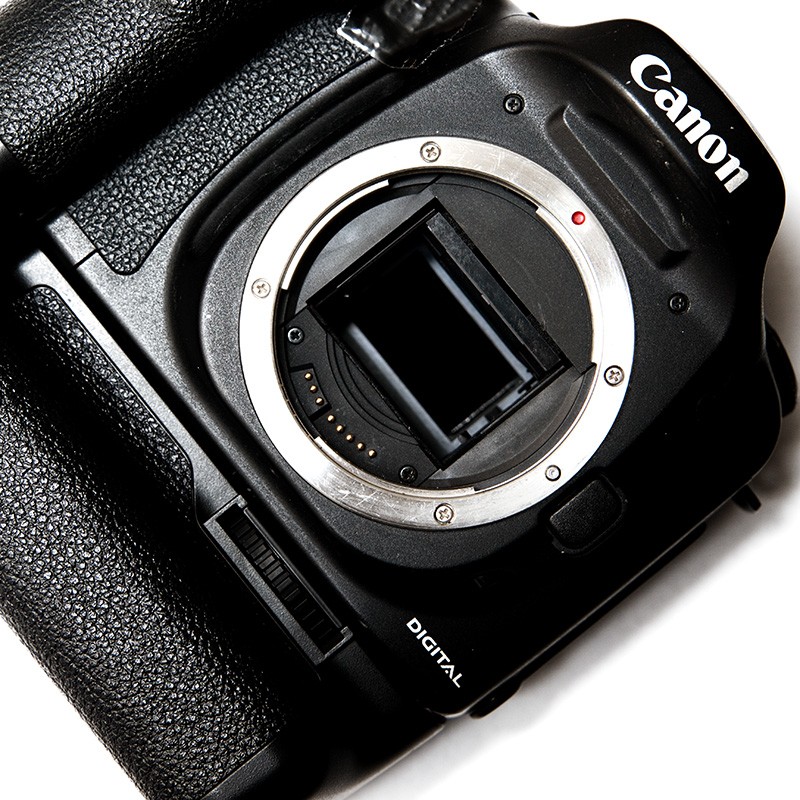 Yeah, digital. Just in case you forget, and try to put film in it.
Yeah, digital. Just in case you forget, and try to put film in it.There are different strengths of infrared filter. The filters are measured in nanometres, nm, with the larger numbers being stronger. Mine blocks electromagnetic radiation with a wavelength shorter than 720nm, which cuts out most visible light except for shades of deep red. Post-processing can separate and work with this colour information to produce odd-looking colour infrared files. Stronger filters, 750nm and above, leave the camera with no visible light to work with, and so you are restricted to black and white images. Weaker filters, from 600-720nm, pass more colour, although because it's biased redwards the results still look odd.
The EXPOSURE
The camera's exposure system isn't touched by the conversion process. It measures visible light, and is generally blind to infrared, and so in practice automatic exposures tend to be spoofed when there are strong infrared sources in the frame. Sunlit trees and foliage tend to be greatly overexposed; the lightmeter sees and exposes for the tree's visible light signature, while the sensor sees a strong blast of infrared. As a consequence I tend to use minus one stop of exposure compensation almost all of the time, minus two on very sunny days, of which there were precious few in England in the latter half of 2010.
There's nothing to stop you putting an IR filter onto the lens in addition to the converted filter inside the camera. This is akin to wearing a condom on top of a watertight diving suit as a means of birth control, or just because you enjoy that kind of thing. You might want to do this if, for example - e.g. use a second filter, not wear a condom on top of a diving suit - if the converted filter is relatively weak, and you want to block all traces of visible light altogether. This has the twin disadvantages of blacking out the viewfinder and confounding the camera's exposure system, but on the positive side the exposures are still in the hand-held range. I have briefly tried this, the end result resembles the output from my DCS 560, totally black and white.
On reflection, it's more like wearing a condom after having a vasectomy than putting a condom on top of a diving suit. You can take the diving suit off, see. With that mental image in place I want you to read the next section, after this photograph of Boris Johnson's office, which I took from a helicopter using a tilt-shift lens:
 It almost looks like a miniature, doesn't it? You can see that Boris Johnson's house has been rubbed smooth. This is because women slide down it. It's a fertility ritual, you see. The women hope that some of Boris Johnson's mojo will rub off on them. So they slide down it, into the scoop. The whole thing is basically a pagan sexual epicentre right in the middle of London, sited right next to a bridge that opens up in order to let ships pass through it. The symbolism could not be more obvious. But what's so wrong with pagan sexual worship?
It almost looks like a miniature, doesn't it? You can see that Boris Johnson's house has been rubbed smooth. This is because women slide down it. It's a fertility ritual, you see. The women hope that some of Boris Johnson's mojo will rub off on them. So they slide down it, into the scoop. The whole thing is basically a pagan sexual epicentre right in the middle of London, sited right next to a bridge that opens up in order to let ships pass through it. The symbolism could not be more obvious. But what's so wrong with pagan sexual worship?I don't usually do repeats, but the following image was shot just bottom-centre of the above, facing the same direction, no women in sight (they had all gone home):
 Beyond the basics of exposure, you must find something interesting to photograph, and then line up the shot in an interesting way. Then shoot and check the histogram and dial in minus one exposure compensation and shoot and shoot; then have a drink and something to eat, and later on review the hundreds of images you shot, and then select the three good ones.
Beyond the basics of exposure, you must find something interesting to photograph, and then line up the shot in an interesting way. Then shoot and check the histogram and dial in minus one exposure compensation and shoot and shoot; then have a drink and something to eat, and later on review the hundreds of images you shot, and then select the three good ones.That's not specific to infrared photography, it's photography in general. The crucial thing is to make people think that those three good shots were the only shots you took, and that they were deliberate, and that every shot you take is good, if not great. Otherwise people will think that you're no better than them, and that you were relying on random chance rather than your genius. You have to convince other people that you possess a mental greatness that they can only dream about, and that you are not like them. Doesn't matter if it's true or not. That's your number one priority as an artist. You are not like them.
The LENS, and FOCUSING
I used a Samyang 14mm f/2.8, which becomes a dead sharp 22mm with a tonne of barrel distortion on a 10D, which PTLens will correct. I don't have any APS-C ultrawides and so the 14mm was an kind of emergency choice; in practice it suits me fine. I came close to selling it, but decided that it's worth more to me as a dedicated infrared lens. I used it all the way through the previous posts in Venice and Barcelona and Montserrat as my only infrared lens, and I have come to the conclusion that 21-24mm is my bag, in terms of focal lengths.
Some lenses have a "hot spot" in the centre of the image when used with infrared; a small patch of increased brightness of differing intensity. The 14mm has this, although it's a kind of diffuse zone that is, most of the time, not obvious. The lens also suffers from flare, as mentioned in the previous post. Here's some of it with the same building I set to music a while back:
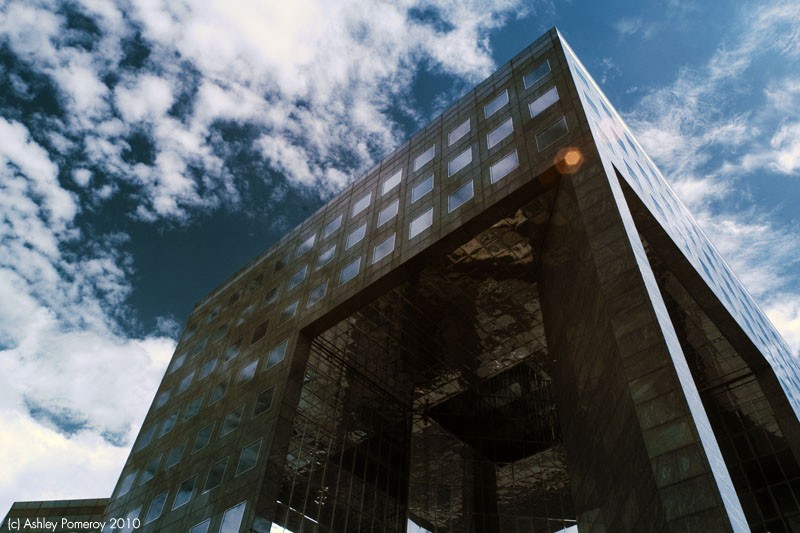 The world is set to music when there's music in your head.
The world is set to music when there's music in your head.There's another reason why the 14mm suits me. Infrared light doesn't focus to the same point as visible light, and so your camera's autofocus will be useless; even the optical viewfinder lies to you, so manual focus isn't the answer. The company that converts your camera can adjust the autofocus system to suit, but in my case this only seems to work with one lens, an ancient Canon 70-210mm f/4. Every other autofocus lens I have tried fails to focus properly. Only the 70-210mm f/4 works, and as a consequence of this every single one of the people portraits in this and previous posts was shot with this lens.
With manual focus lenses it takes a bit of trial and error until you work out how to focus to infrared infinity. Shooting a portrait at close range at f/1.4 would require a tape measure and lots of patience. The Samyang 14mm is odd, in that infrared infinity focus coincides exactly with the infinity focus mark on the lens, which is also at the extreme clockwise end of the focus ring's travel. Therefore, in order to achieve infinity focus all I have to do is twist the lens as far as it goes clockwise and hold it there, which leaves me free to worry about composing the image. After stopping down to f/11 everything from a few feet to infinity is in focus. Most of the landscape images in this and previous posts were shot at f/11 or f/8, varying the ISO to keep the exposure above 1/30th or so.
And that is the technology. In the next exciting episode I will show you how to turn the muddy-browny-red smudged mess that a converted camera produces into a sharp contrasty work of colourful artistic brilliance which you can put onto a blog so that ten people can scroll past them in order to get to Ulorin Vex's breasts.
Or I might write about something else, and not post part two for six months.
EDIT: There's another thing. Infrared radiation tends not to be scattered by haze, and so infrared landscape photographs often have an unreal clarity, as if shot on the moon, where there isn't any air. Without haze to provide a depth cue the image often looks a bit flat, as if it was a well-lit miniature rather than a distant mountain, but on the positive side the camera captures nine metric tonnes of detail. Here's a shot taken from Montserrat's monastery:
 Here's a 100% crop with a little bit of sharpening:
Here's a 100% crop with a little bit of sharpening: That dot on the road is a car, and I can tell it's a car and not a truck because the next picture has some trucks where the car used to be. Judging by Google Earth, the car is about one and a third miles away and two thousand feet down. If I remember my maths correctly there's a clever sum you can do to work out the length of the third side of a triangle if you know the length of the other two sides, and this is the first time in my life that I've ever felt the need to find this out. (guesses) It's probably something like a mile and a half or so.
That dot on the road is a car, and I can tell it's a car and not a truck because the next picture has some trucks where the car used to be. Judging by Google Earth, the car is about one and a third miles away and two thousand feet down. If I remember my maths correctly there's a clever sum you can do to work out the length of the third side of a triangle if you know the length of the other two sides, and this is the first time in my life that I've ever felt the need to find this out. (guesses) It's probably something like a mile and a half or so.So, yes, infrared photography allows you to see a Spanish car from a mile and a half away or more.


